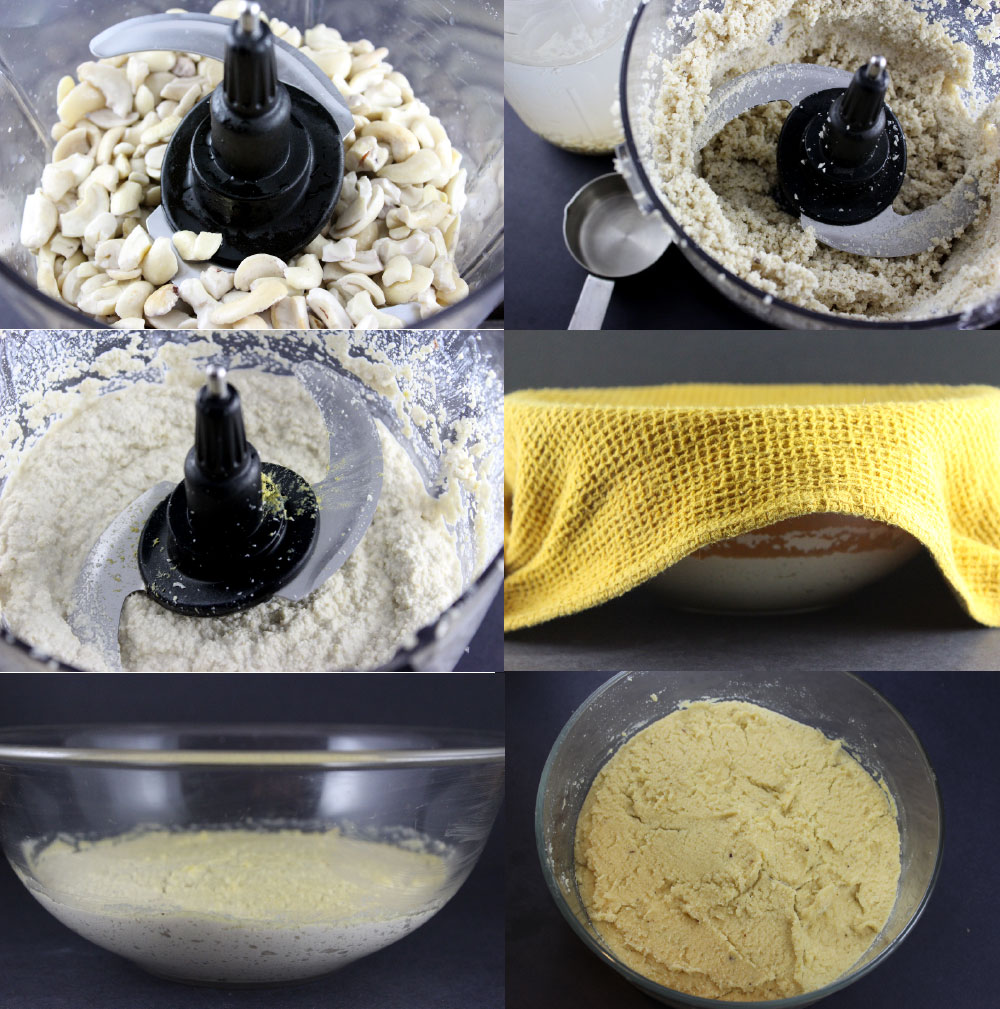Smooth and creamy, raw vegan cream cheese made from cashews and fermented with rejuvelac. This cashew cheese is the perfect base for countless different cheesy recipes and is probably one the healthiest cheeses you could ever make.
My favorite two recipes to make from this cultured cashew cheese base is a garlic and herb cheese spread, great for crackers and veggies, and the king of all cheesecakes, the cultured cashew cheesecake. I also like to make fermented raw vegan jalapeño poppers with this cheese stuffed inside and wrapped with sprouted wheat berry breading. There are literally endless recipes you could create with this cheese, and I’m excited to show you a few!
Warning this is a fermented cashew cheese that takes time, if you are looking for a quick and easy cheese this may not be the recipe for you. If you are looking for a decadent, premium cheese filled with probiotics, one that takes time and love to make, than this is the cheese recipe for you. Not only does this cheese taste incredible but it also makes you feel good and is easily digested which means you have more energy to do the things you love to do.
Before you can make this cultured cashew cheese base you must make rejuvelac ahead of time.

Cashew cheese was one of the first raw food cheeses I learned how to make, it’s really quite quick and easy. Once you have mastered the basics you can move on to the more advanced fermented cheeses such as this one. It’s not that fermenting is extremely hard it’s just it takes time and there are extra steps involved. Making the rejuvelac is one of those extra steps but in the end it’s worth it. Rejuvelac is basically fermented water and grains, and is the perfect starter for our cream cheese. I believe rejuvelac is a better alternative to probiotic capsules which can get fairly expensive.
Nutritional yeast is an inactive yeast used for an enhanced cheesy flavor and is said to provide vegans and vegetarians with vitamin b12. Blend a little nutritional yeast with some cashews and rejuvelac and you’ve got yourself a decadent cheese. The next step is fermentation, all you have to do is leave the bowl of cheese covered in a room 65-85 degrees for 2-3 days or until you see a crust on top like the last 2 picture just above the last paragraph.
Making Cultured Cashew Cheese in a Blender vs Food Processor
Refer to the last 2 pictures above again. The bowl to the left was fermented for the same amount of time and at the same time as the bowl on the right. As you can see the bowl on the left is lighter and doesn’t have as crusty of a top as the bowl on the right. So what’s the difference you might ask? The bowl on the left is smoother and creamier because it was blended using a high speed blender, and yes a regular old blender will do the job just as well as an expensive vitamix. Be careful with a vitamix or any high speed blender because you will end up making nut butter if you’re not careful.
Make sure you scrape the sides to get all the cashews as smooth as possible and you also want to make sure you are adding only a tiny bit of rejuvelac at a time with either a blender or food processor. The cheese on the right with the yellow tint was made with a ninja food processor. It is much thicker and grainier than the cheese on the left. This cheese is more ideal for cheese spreads for crackers rather than for a cheesecake, but as with everything it all depends on your preference. I always encourage everyone to experiment and figure out which way works best for them. There are endless possibilities when it comes to cultured cashew cheese!
Cultured Cashew Cream Cheese Base
INGREDIENTS
- 4 cups cashews
- 2 tbsp nutritional yeast
- 1 cup rejuvelac start with a little less than 1 cup and add more as necessary.
INSTRUCTIONS
- Soak cashews for at least an hour and no longer than 3 hours.
- Rinse and drain cashews.
- Grind cashews and nutritional yeast in blender or food processor.
- Add a little bit of rejuvelac at a time into the blender of food processor until the cashews are creamy.
- Process until smooth.
- Put cheese into a glass bowl, smooth out the top and cover with a towel.
- Let sit out for 2-3 days or until the top hardnens and you see a lot of little air bubbles underneath the cheese "crust".
NOTES
After the base is made you can then add any number of ingredients to spice up your cheese my favorite being garlic, chive, paprika, black pepper and sea salt. Or my other favorite coconut nectar, coconut oil, vanilla and sea salt on top a pecan, flax seed, date crust. Yes that is the cashew cheesecake, divine.
Make Cultured Cashew Cheesecake with Cinnamon Pecan Crust!






Comments 3
Pingback: Recipes To Get You Started On Making Vegan Cheese - Gratitude and Greens
Do you still add the nutritional yeast, even if you plan to use the cheese for cheesecake? Do you scrape the crust off the top or blend it back in before using?
Author
Hi Alex, yes I still use the nutritional yeast for cheesecakes and yes I mix the crust in too. Hope you enjoy every bite!